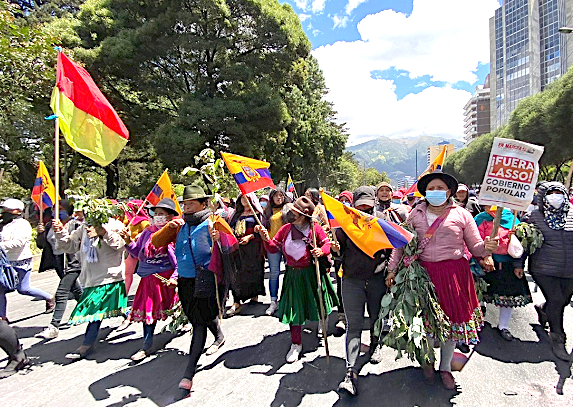Spanish-language news media saw legitimacy in Ecuador’s summer 2022 indigenous protests, while English-language outlets more often portrayed the social movement as violent and dangerous.
News outlets cover social movements from different perspectives, and the way a movement is visually and linguistically framed affects public perceptions of it. In June 2022, a series of protests ignited in Quito, Ecuador. These protests were widely followed across Latin America, and covered by news organizations around the world. We decided to analyze news coverage of this protest in three major newspapers: El País of Spain, The Guardian of England, and in the The New York Times, and on one television network, Telesur, to examine different framings of the same issue. We found a difference between Spanish-language and English-language news coverage, in which two contrary views of the event were portrayed: the two Spanish-language news outlets framed the protests as a legitimate struggle for basic rights, further inspiring many Ecuadorians to join the protests and challenge the government. By contrast, the two English-language news outlets portrayed the social movement as violent and dangerous.
On June 13, 2022, members of the Confederation of Indigenous Nationalities of Ecuador, known as CONAIE, walked, danced and sat on the streets protesting for their civil rights, and criticizing the national government for dramatically raising prices on basic necessities, such as food, transport and electricity, across the country. Like Indigenous populations across Latin America, Ecuador’s Indigenous peoples face widespread racism, poverty and a lack of access to resources, including healthcare, quality education and stable employment. These factors cause a much higher poverty rate among Indigenous communities than in the general population. Of Ecuador’s 17 million residents, around 1.1 million belong to one of the 15 Indigenous groups (6% of the population), with the largest groups the Kichwa, Cofán and Shuar.
The CONAIE protests continued for 18 days, reigniting Ecuador’s Indigenous rights movement on the world stage, with thousands of protesters getting involved, especially students from the capital, Quito, and surrounding towns such as Cuenca and Ambato. While the protesters were overwhelmingly peaceful, there were instances of police-protester clashes (as in the United States, Ecuador’s police have a history of sometimes treating protesters with physical violence, tear gas and guns.) However, the protests grew so large and attracted so much popular support that on June 30, 2022, an agreement was reached between the government and the public. Ecuador’s residents were successful in getting the government to agree to lower the cost of fuel and other daily essentials, providing millions of families with assistance. They were also able to establish a deal that set limits on the expansion of oil exploration, prohibiting mining in Indigenous lands, national parks and near fresh water sources. This is something that Indigenous people have struggled to achieve for decades, given that mining on and near Indigenous lands has destroyed their communities and poisoned their water.

Madrid’s daily El País covered Ecuador’s protests extensively, from the time they started until the June 30th agreement was reached. In a series of sympathetic articles, El País provided historical context and discussed the tactics protesters used, illustrating how events unfolded across the country. Coverage included multiple photos of Indigenous people and students standing together in solidarity, holding Ecuadorian flags. Despite some violent incidents during the 18 days of protests, El País focused on the urgent reasons for the protests. The paper covered both peaceful and violent episodes of the demonstrations, but made sure that the cause of the movement (a deterioration of democratic rights and living conditions) wasn’t overshadowed by the violence episodes. Headlines from El País, such as “Ecuador warns that ‘democracy is at serious risk,’” correlated this protest with larger struggles for social justice in Ecuador. Other headlines celebrated the signing of a peace agreement between protesters and the government, such as: “The government of Ecuador and indigenous organizations sign peace after 18 days of chaotic protests.” El País included a powerful quote from CONAIE president, Leonidas Iza, that emphasized the people’s democratic right to protest: “We, the indigenous movement of Ecuador, have declared to remain in the fight and in resistance, as a right of Ecuadorians.” Indicating his suspicion that the press would focus mainly on the violence, Iza was also quoted by El País as saying: “Comrades and compañeras, we cannot delegitimize our struggles, they cannot be confused with vandalism…Let’s not leave an image [of violence] like the one they intend to position; these people are peaceful. These people also have dignity.”
Telesur, a Latin American television network viewed in many Spanish-speaking countries, broadcast live footage of Indigenous people dancing in the streets to traditional Indigenous music, showing the peaceful nature of the protests. When things turned violent, Telesur denounced the death of protesters at the hands of police, with headlines such as: “Four protesters killed by police” and “CONAIE indicated that the protester died from ‘penetrating trauma to the thorax and abdomen caused by pellets.’”
Both outlets framed the protests as a legitimate struggle for basic rights, further inspiring many Ecuadorians to join the protests and challenge the government.
By contrast, the two English speaking news outlets we examined portrayed the social movement as violent and dangerous. With visual imagery portraying clashes and sensational headlines, these outlets misconstrued the identity of the social movement and its protesters. A headline The Guardian, read: “Ecuador deal reached to end weeks of deadly protests and strikes.” The use of the word “deadly” portrayed this movement as overwhelmingly violent, which was not the case. The Guardian published an image of angry people on the streets that gave the impression of rioting, as compared to photos in El País of the peace agreement being signed. Both articles discussed the protestor-government accord, but the visual framing differed substantially.
While El País framed the social movement as a valiant effort to improve democracy in Ecuador, The Guardian’s lead on the day of the peace accord associated violence, paralysis and death with the protest: “Ecuador’s government and the country’s main Indigenous group have reached an agreement to end 18 days of often-violent strikes that had virtually paralyzed the country and killed at least four people.” The Guardian’s editors chose to publish photos of demonstrators in the street in chaotic clashes with law enforcement.
The more sympatheric El País lead reads: “The march of indigenous people wielding spears through the center of Quito on Wednesday [ended when] the weapons were symbolically buried with an act of peace.” This sentence conveyed the emotion of the moment, highlighting Indigenous peace traditions (symbolically burying spears) rather than malicious intent or violence.
Meanwhile in the United States, The New York Times also chose to portray images of paralysis, destruction and violence, writing: “The country’s capital has been virtually paralyzed by demonstrators, and the government says it has lost control of a small city in the Amazon to protesters wielding guns, spears, and explosives.” This notion of a government “losing control,” and being “paralyzed” reinforced centuries-old stereotypes of Indigenous people as “uncivilized savages” threatening the “civilized” government.
As social movement scholar Charlotte Ryan notes in her classic book Getting Framed, “News frames make the world look natural…They determine what is selected, what is excluded, what is emphasized” (Ryan, p.2). News framing isn’t simply the choice of words, but the utilization of visual images as well. In this case, depending on which news outlet people got their news from, they may have defined Ecuador’s protest as violent and deadly without sympathizing with its causes or seeing its peaceful aspects, such as Indigenous music and dancing in the streets, or workers, students and Indigenous people marching arm and arm together. The differing news coverage published in these news outlets portrayed Indigenous protesters within either “legitimizing” or “delegitimizing” frames, which Ryan has argued can make audiences sympathize with or reject protesters and their sociopolitical struggles.
References
Massey, Garth. Ways of Social Change: Making Sense of Modern Times. SAGE Publications, Inc., 2016.
Ryan, Charlotte. Prime Time Activism Media Strategies for Grassroots Organizing. South End Press, 1991.
España, Sara. “El Gobierno De Ecuador y Las Organizaciones Indígenas Firman La Paz Tras 18 Días De Caóticas Protestas.” El País, 30 June 2022, https://elpais.com/internacional/2022-06-30/el-gobierno-de-ecuador-y-las-organizaciones-indigenas-firman-la-paz-tras-18-dias-de-caoticas-protestas.html.
“Ecuador’s Recurrent Cycle of Violence over Indigenous Rights.” Human Rights Watch, 15 Aug. 2022, https://www.hrw.org/news/2022/08/13/ecuadors-recurrent-cycle-violence-over-indigenous-rights.
“Ecuador Deal Reached to End Weeks of Deadly Protests and Strikes.” The Guardian, Guardian News and Media, 1 July 2022, https://www.theguardian.com/world/2022/jul/01/ecuador-deal-reached-to-end-weeks-of-deadly-protests-and-strikes.
“Indigenous Justice in Ecuador.” IWGIA, https://www.iwgia.org/en/ecuador.html#:~:text=Indig,has%20ratified%20ILO%20Convention%20169.
León, José María. “Ecuador Roiled by Protests Set off by Rising Fuel and Food Prices.” The New York Times, The New York Times, 23 June 2022, https://www.nytimes.com/2022/06/23/world/americas/quito-ecuador-protests-inflation.html.


